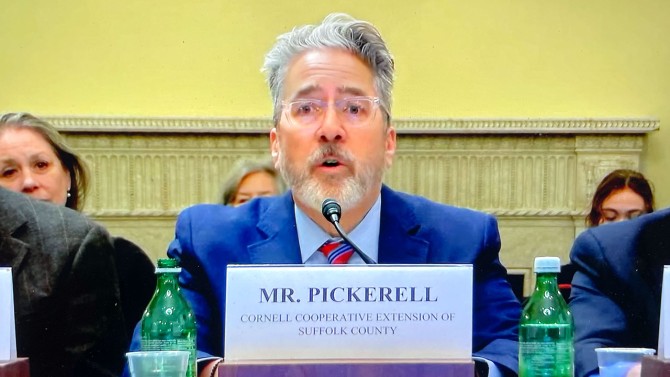Long Island Sound critical for fishers, families, CCE expert tells Congress
By Blaine Friedlander, Cornell Chronicle
After enduring decades of pollution, Long Island Sound’s wildlife, fish and water quality are returning to normal – prompted by research and action started 40 years ago, a Cornell expert said at a congressional hearing Jan. 18.
The Long Island Sound now contributes billions of dollars annually to the regional economy, while federal funding to sustain the sound’s environmental integrity is up for congressional renewal, said Chris Pickerell, M.S. ’93, director of Cornell Cooperative Extension’s Marine Program in Suffolk County on Long Island, who testified before the U.S. House Subcommittee on Water, Wildlife and Fisheries.
“Managing an estuary of this size and complexity is a massive undertaking,” Pickerell said.
Pickerell told the subcommittee that federal funding helps to maintain water quality monitoring, habitat restoration and debris removal, and supports farmers around the region to develop management practices that protect the sound’s watershed.
Pickerell appeared at the subcommittee, part of the Committee on Natural Resources, in support of a bipartisan House bill to reauthorize $40 million in annual federal funding for the Long Island Sound Study, a research and action group created by New York, Connecticut and the U.S. Environmental Protection Agency to conduct scientific research, educational and environmental health programs for the sound.
Rep. Nick LaLota (R-New York) and Rep. Joe Courtney (D-Connecticut) introduced the bill (H.R. 5441) in September as the Long Island Sound Restoration and Stewardship Reauthorization Act of 2023.
Sen. Kirsten Gillibrand (D-New York), who introduced a companion bill (S. 2793) in the U.S. Senate, said last fall that the sound’s economic viability contributes about $9.4 billion annually to the regional economy, which is dependent on sport and commercial fishing, boating, recreation and tourism.
Long Island Sound is a 1,300-square-mile body of water lying between the North Shore of Long Island and the southern coast of Connecticut, stretching to the Rhode Island border. Its watershed encompasses 16,000 square miles spread across six states, with recreational, environmental and business assets representing more than $1 trillion, Pickerell said.
LaLota, who represents eastern Long Island, said the sound has suffered from over-development, pollution, natural habitat deterioration, algae growth, threats to native species and poor water quality.
“For many, the Long Island Sound and our waterways are our way of life,” LaLota said. “From environmentalists to [fishers] and anglers to animal welfare advocates to engineers and more, the sound is how folks provide a better future for their families.”
In 1985, the Long Island Sound Study partnership began to address the sound’s low oxygen levels and excessive nitrogen, damaged wetlands and depleted fish and shellfish populations. Since then, the federal funding – along with other matching money – has helped to restore the sound.
For example, Pickerell said, the Unified Water Study, a collaboration with more than 25 groups and municipalities, has developed protocols to collect consistent, comparable data on the health of the sound’s bays and harbors.
Pickerell grew up on the sound. “My father is a bayman, boat builder and oyster farmer who worked in the harbors of Long Island’s North Shore, harvesting clams to support our family,” he told the subcommittee. “When I was very young, I spent many hours on his boats, mostly watching and sometimes helping.
“Through this experience,” he said, “I gained a deep appreciation for – and a unique understanding of – our local waters.”
In his three-decade scientific career, Pickerell has monitored and restored coastal habitats and near-shore terrestrial environments. As director of CCE’s Marine Program in Suffolk County since 2013, he guides a staff of marine biologists and educators through program areas that include aquaculture, fisheries management, water quality monitoring, habitat restoration, geographic information systems and youth education.
He testified about coastal seagrass and salt marsh habitat restoration, which supports commercial and recreational fishing, as well as valuable shoreline infrastructure.
At the end of the hearing, LaLota asked Pickerell what could happen if federal funding disappeared.
“We wouldn’t see the milestones reached that have been achieved so far,” Pickerell said. “There have been so many projects of all different natures that are taking place that have helped to restore habitat, fisheries, recreation, education – all these things.”
Without funding, he said, “we’d actually go in reverse… So those improvements that have happened would start to wane and we wouldn’t see any advancement in habitat, value … all the things I talked about. We need to keep this going so that momentum maintains itself.”
Media Contact
Get Cornell news delivered right to your inbox.
Subscribe


